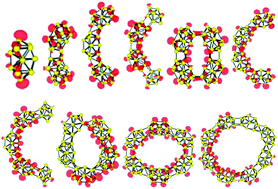Tin clusters formed by fundamental units: a potential way to assemble tin nanowires
Abstract
First-principles calculations using density functional theory (DFT) have been performed on Snn clusters up to 561 atoms. The results show that thread-like structures based on the unit of Sn15 are favored for n up to 60, and then a plate-like Sn90 unit is preferred. The unique structures are explained by the strong covalent bonding character of Sn15 units. Due to the weak binding forms among layers, plate-like stacked structures are less preferred than octahedral (Oh) structures with n = 231. Besides, perfect icosahedral (Ih) structures are always more favorable than Oh isomers. The structural deviation of larger tin clusters from that of typical metal clusters may originate from the disparity in α/β tin bulk and more compact fcc bulk phases. Compared with the previous studies, we conclude that the weaker the bulk metallic character, the larger the


 Please wait while we load your content...
Please wait while we load your content...